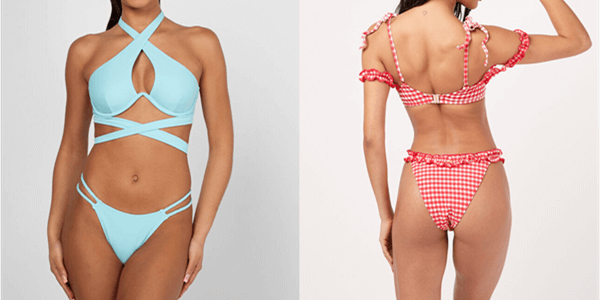
Roupa de banho x Lingerie: comparando tecidos para conforto e função
A roupa de banho e a lingerie são dois tipos de roupa que requerem diferentes tipos de tecidos para serem funcionais e confortáveis. A seguir, uma comparação dos tecidos mais usados para roupas de banho e lingerie:
| Tecido | roupa de banho | Lingerie |
|---|---|---|
| Nylon | ✔️ | ✔️ |
| Poliéster | ✔️ | ✔️ |
| Spandex | ✔️ | ✔️ |
| Algodão | ❌ | ✔️ |
| Seda | ❌ | ✔️ |
| Linho | ❌ | ✔️ |
| raiom | ❌ | ✔️ |
| Modal | ❌ | ✔️ |
| Bambu | ❌ | ✔️ |
Tecidos Sintéticos
Nylon, poliéster e spandex são os três tecidos sintéticos mais usados para roupas de banho e lingerie. Eles são conhecidos por sua alta elasticidade, durabilidade e resistência a danos causados pela exposição ao sol, água salgada e cloro. Além disso, fornecem bom suporte, compressão e retenção de forma, tornando-os ideais para ambos os tipos de roupas.
Fibras Naturais
Algodão, seda, linho e lã são fibras naturais comumente usadas em lingerie, mas não em roupas de banho. O algodão é respirável, macio e confortável, mas absorve a água e leva muito tempo para secar, o que o torna inadequado para roupas de banho. A seda é um material luxuoso e leve que é confortável de usar, mas não tão durável ou seco quanto materiais sintéticos, tornando-o inadequado para roupas de banho. O linho é um tecido leve e respirável que é confortável de usar, mas não fornece alongamento ou suporte suficiente para roupas de banho. A lã é quente e confortável, mas não seca rápida e absorve a água, tornando-a inadequada para roupas de banho.
Outros materiais
Além dos tecidos listados acima, outros materiais que às vezes são usados para roupas de banho e lingerie incluem rayon, modal e bambu. Esses materiais são feitos de fibras naturais, mas geralmente são misturados com materiais sintéticos para aumentar sua durabilidade, elasticidade e propriedades de secagem rápida.
Tratamentos exclusivos e métodos de processamento
Em relação às roupas de banho, vários tratamentos exclusivos e métodos de processamento são usados em tecidos para torná -los adequados para uso na água. Por exemplo, os tecidos de moda de banho são frequentemente tratados com produtos químicos como acabamentos resistentes ao cloro, protetores de UV e repelentes de água para melhorar sua durabilidade, proteger contra desbotamento e repelir água. Os tecidos de moda de banho são frequentemente fabricados usando técnicas de tecelagem especializadas que fornecem alongamento e suporte extras, como malha circular ou de urdidura.
Conclusão
Escolher um tecido adequado para roupas de banho e lingerie é crucial para conforto e desempenho. Ao entender as propriedades de diferentes tecidos e seus métodos de processamento, você pode selecionar o material apropriado para o objetivo adequado e garantir que sua roupa seja confortável, durável e funcional. Materiais sintéticos como nylon, poliéster e spandex são ideais para roupas de banho, enquanto fibras naturais como algodão, seda e linho são preferidas para a lingerie.
